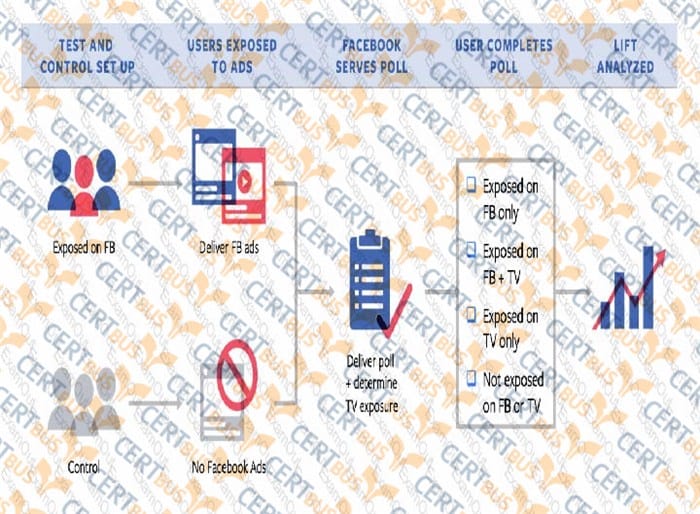Exam Details
Exam Code
:410-101Exam Name
:Facebook Certified media buying professionalCertification
:Facebook CertificationsVendor
:FacebookTotal Questions
:150 Q&AsLast Updated
:Aug 11, 2025
Facebook Facebook Certifications 410-101 Questions & Answers
-
Question 21:
What can you expect from an MTA Partner Program within Facebook Measurement Partners?
Choose ALL answers that apply.
A. Measure lift in sales using partner-based ROI measurement solutions.
B. Measure and compare the effectiveness of advertisers' marketing channels in terms of contribution to sales, efficiency, and ROI.
C. Aggregated reporting across multiple mobile ad networks, powered by Facebook attribution data.
D. People-based multi-touch attribution reporting across all publishers, including Facebook.
-
Question 22:
You have just gotten the results from a conversion campaign you ran for a membership site for 2 weeks:
There were 9 new customers acquired through the campaign.
Customers usually pay 6 months on average.
The monthly membership fee is $15.
The total amount you spent on the campaign was $400.
What is the ROAS for this campaign?
Choose only ONE best answer.
A. $102.50
B. $265
C. -$265
D. $410
-
Question 23:
An eCommerce recently installed the Facebook pixel on their website to better understand the ROAS of the online marketing efforts.
After two months, they've spent $3,500 in online conversion campaigns, and generated $6,000 in revenue.
You realize that the ratio for the ROAS is 1.71:1
What does this ratio mean?
Choose only ONE best answer.
A. For every $1 you spend on a campaign, you generate $3.5 of revenue.
B. For every $1 you spend on a campaign, you generate $1.71 of revenue.
C. For every $10 you spend on a campaign, you generate $1.71 of revenue.
D. For every $1 of revenue, you spend $1.71 in advertising.
-
Question 24:
Your client is running a marketing campaign both on TV, Facebook, and Instagram.
They plan to run a campaign for 3 months and spend $50,000 online, plus $100,000 on TV placement ads.
Your client wants you to propose a method to better measure the reach of the campaign to a specific audience. They also want delivery recommendations to optimize the impact that the campaign is having.
What is the best measurement solution for this?
Choose only ONE best answer.
A. Nielsen DAR
B. Nielsen TAR
C. Audience Insights
D. Millward Brown Brand Lift
E. Nielsen Brand Lift
-
Question 25:
Which metrics should a brand awareness campaign use in order to measure the effectiveness of their campaign?
Choose ALL answers that apply.
A. CPM
B. Reach
C. CPC
D. Brand Lift
E. Frequency
-
Question 26:
What are the three main aspects Facebook tries to impact when launching campaigns through their auction?
Choose ALL answers that apply.
A. Audience Outcomes
B. Brand Outcomes
C. Sales Outcomes
D. Impact Outcomes
E. Reach Outcomes
-
Question 27:
What are three metrics that video can have a huge impact on brands?
Choose ALL answers that apply.
A. Ad Recall
B. Brand Awareness
C. Cost Per Click
D. Purchase Consideration
-
Question 28:
What does a 1-day view and 28-day click attribution window mean? Choose ALL answers that apply.
A. Actions happened 28 days after someone viewed your ad
B. Actions happened 1 day after someone viewed your ad.
C. Actions happened 28 days after someone clicked your ad.
D. Actions happened 28 days after someone viewed your ad.
-
Question 29:
Your client is interested in running a campaign for 1 month and then do a brand lift study. But, before proceeding with the study, he/she would like to understand more about it.
Choose ALL answers that apply.
A. People within the control group that will view your ads become part of the exposed group.
B. People within the test group that will view your ads become part of the exposed group.
C. The difference between the test group and the control group are analyzed to see the results of a brand lift study.
D. The difference in response between the exposed group and the control group are analyzed for results of your brand lift study.
E. You can set up a brand lift study through your Business Manager.
-
Question 30:
You are planning on running a brand lift study for your client, what are some of the metrics you can measure through the study?
Choose only ONE best answer.
A. Percentage point lift, message association, and cost per click.
B. Percentage point lift, message association, favorability, and cost per click.
C. Percentage point lift, cost per estimated incremental person who remembers your ads, and estimated incremental number of people who remember the ad.
D. Cost per click, cost per mile, percentage point lift, and video views.
Related Exams:
Tips on How to Prepare for the Exams
Nowadays, the certification exams become more and more important and required by more and more enterprises when applying for a job. But how to prepare for the exam effectively? How to prepare for the exam in a short time with less efforts? How to get a ideal result and how to find the most reliable resources? Here on Vcedump.com, you will find all the answers. Vcedump.com provide not only Facebook exam questions, answers and explanations but also complete assistance on your exam preparation and certification application. If you are confused on your 410-101 exam preparations and Facebook certification application, do not hesitate to visit our Vcedump.com to find your solutions here.

